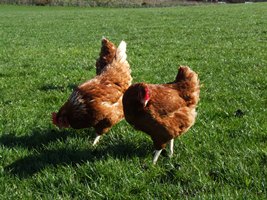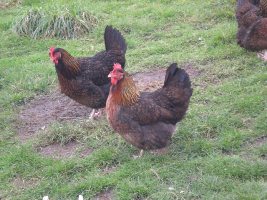Encompassing opportunities to lower costs and emissions. Current poultry and egg production in the UK is responsible for a fraction of the GHG emissions associated with red meat production, as the methane contribution of this system is only marginal in comparison.


Production Systems
Research has suggested that egg production globally averages 2.2kg of CO2e per dozen eggs, which on a per kilogram of protein basis is lower than the production of both red and white meat sources. A large proportion of emissions associated with poultry originates from the food they are fed, contributing up to 63% of embodied carbon.
Feeding Systems
However, current production systems are based very substantially on cereal diets and unlike forage based ruminant diets, arable land growing crops to feed pullets and layers, despite the higher rates of feed conversion, is less efficient than growing crops for direct human consumption for GHG emissions. Almost half of all GHG emissions for both meat and egg production is associated with the growing (and to a much lesser degree the processing and transporting) of feeds for the birds:
- Nitrous oxide (N2O) accounts for around 50 -60% of all GHG emissions.
- Carbon dioxide (CO2) also accounts for 30-40%
- And Methane (CH4) makes up around 5-10% of all GHG emissions – mainly from anaerobic storage of slurry.
The majority, 60 – 70% of all N2O emissions are associated with the growing of the imported feeds, with 30-40% associated with the storage of manures and their subsequent application.
How to Minimise Emissions
The opportunities for lowering emissions associated with imported feeds are small, other than ensuring efficient utilisation of the feed and minimising wastage which are standard management practices, the only other ways of reducing this figure are how the feeds are sourced, particularly if there is a significant proportion of soya in the ration. There extensive systems differ to intensive systems as there is generally a lower feed demand, with less energy and protein dense diet corresponding to a slower growth rate. Best husbandry practices to reduce chick mortality rates and health burdens which will also benefit both emission contribution and the farm’s economic bottom line.
Manure Management
Chicken manure is much higher in nitrogen (as uric acid) than other livestock manures and is therefore susceptible to much higher losses of urea and the potential for subsequent oxidation to N2O. Keeping the heap as aerobic as possible will reduce the production of NH3 and covering the heap helps further. Because of the high levels of uric acid, the nitrogen is more readily available to plant uptake when spread on land, so ensuring the optimum rate and timing for application will also reduce losses. Methane emissions are nearly all associated with manure storage (chickens digestion does release some methane but it is relatively negligible) and mainly occur in the anaerobic areas of the manure store, and can be reduced by aerating any storage.
Heating and Energy Requirements
CO2 emissions can be significant in poultry rearing and egg production, depending on the system used and the energy source. Poultry production can require significant energy inputs for heating. The most convenient source of heat is fossil fuels. If any investment is planned, installing renewable heat sources to provide the base load of the heating would make a large difference in this area. Such systems may be ground source heat pumps or biomass boilers possibly with a heat accumulator tank. Ensuring that the insulation and draft proofing is effective and all equipment is well maintained and working at optimum capacity also helps. Carrying out an energy audit will reveal how energy is used on the farm and how your farm compares with similar units and what opportunities there are for saving energy or generating it.
Summary
Energy use and CO2 emissions in egg and poultry production are easy to quantify, under your direct management and unlike other sectors, represent a substantial part of the GHG emissions from the farm. Giving attention to this aspect, along with overall flock health and output will directly benefit both the farm business and the environment.

